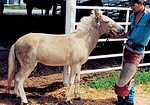Advertise Follow Us
Articles Tagged with ''Diagnoses''
Suspected and unproven navicular disease concerns should sound a warning bell
Read More
Tackling Laminitis
While much has been learned about laminitis over the past 25 years, it's still critical to evaluate each horse
Read More
Navicular Problems Can Trap Farriers
Horseshoers can make first assessment of potential navicular problems, but ultimate diagnosis requires veterinary involvement to avoid liability
Read More
Open MRI Offers New Option For Diagnosing Tricky Hooves
Magnetic “collars” make this diagnostic method more practical while providing high-quality images of what’s happening inside the foot
Read More
Vet's Corner
Diagnosis And Treatment Of A Spontaneous Rupture Of The Deep Digital Flexor Tendon
Therapeutic shoe with heel extension seen as key to successful outcome
Read More
How To
Using Digital Thermography For Diagnosing And Pinpointing Abscesses
With a little experience, locating hoof and leg injuries can be quick and easy
Read More
White Line Disease Declines As Farrier Knowledge Increases
In 1997, American Farriers Journal editors produced an in-depth look at how farriers were dealing with white line disease. Here’s what’s happened since then.
Read More
What's This?
Contest Winners
See who took home three FREE horseshoeing videos for the best diagnosis and treatment suggestions for this hoof
Read More
Vet's Corner
Diagnosing and Treating Ringbone
Early diagnosis and treatment is essential for any degree of success
Read More










